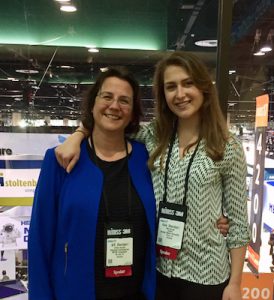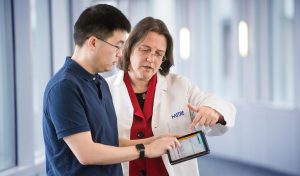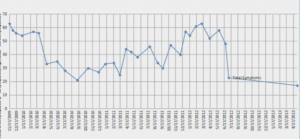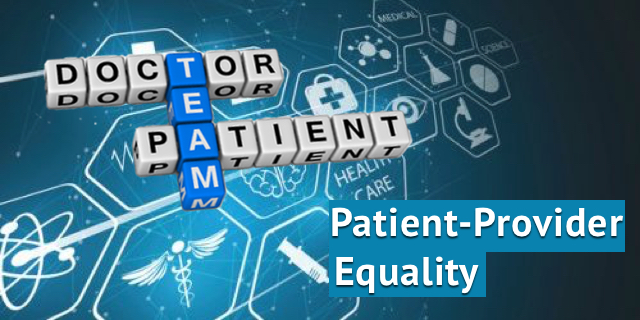The Healthcare Information and Management Systems Society (HIMSS) conference held in Las Vegas in  March is an enormous yearly event filled with marketers, vendors, health IT professionals, executives in healthcare and clinicians. At last month’s conference, an unlikely pair took the stage: mother and daughter, Kristina and Kate Sheridan, spoke about being a caregiver and a patient.
March is an enormous yearly event filled with marketers, vendors, health IT professionals, executives in healthcare and clinicians. At last month’s conference, an unlikely pair took the stage: mother and daughter, Kristina and Kate Sheridan, spoke about being a caregiver and a patient.
Kate’s patient story
When Kate was 11 years old, an infected tick bit her. She developed the classic rash of Lyme disease and was prescribed a three week course of antibiotics. But the antibiotics didn’t work. In fact, over the next three years, her health declined to the point where she had seen “over 30 doctors, was given 15 different diagnoses and was hospitalized five times.” She stated, “Over that time, the disease progressed through my body and my cognitive abilities began to fade.” In her presentation, she described searing pain that lasted for months, “I went from a straight A student to a special needs student who couldn’t read a page in a book. It moved through my limbs, swelling every joint in my body and robbing me of my energy. I went from being a competitive athlete to bed-ridden.”
With so many physicians and diagnoses, her clinical appointments became a blur. “It felt like I walked into the appointment as a person and I sat down as a diagnosis,” Kate remembered. When asked about her symptoms over the month or so since she was last seen by her clinician, Kate and her parents were at a loss. “I had so many diagnoses that accurately communicating my medical history had become impossible,” she said.
At one appointment, a specialist wondered why she didn’t have tingling in her feet. Kate replied that she didn’t realize that it was a symptom, something to tell her doctor. This was a turning point for Kate and her family. After that appointment, her parents asked Kate about her body, from head to toe. They identified 26 separate symptoms. Her parents collected all her medical data into an Excel sheet and then created a tracking system for Kate to input information on the severity of her 26 symptoms.
By overlaying the symptoms with her medical records, they were able to communicate the whole story with her physicians. “Being able to capture that information ahead of time insured that we disclosed everything fully and allowed us to visualize my symptoms over time,” Kate said.
Kristina’s caregiver story
Kristina took up the narrative. As an aeronautical engineer, her work involved launching satellites. But that work was easy compared to caring for her daughter and son (who had also contracted Lyme disease which had become chronic.)
“It was easier for me to walk into that launch control center and launch a satellite than it was for me to be at home and manage my children’s care.” This was because she had worked with the designers of the controls that launched the satellites. However, with her children she had nothing, no tools to help her decide if they needed to go to the emergency room or wait. “All I had to go on was my gut and a piece of paper that the hospital might have given me,” she related in her presentation.
She also realized that her children were the experts in their disease. Giving them the tools they needed to communicate effectively with their physicians made an enormous difference in their care.
These realizations influenced Kristina’s decision to leave her aeronautical engineering job to become involved with creating a tool at a non-profit called Mitre. Called the Patient Toolkit, it functions like the excel sheet to help other patients. The Patient Toolkit includes a journaling function, a calendar, and capabilities for scheduling to help keep up with medications, appointments and life, in general, as well as symptom-tracking that maps to the appropriate code standards.
with creating a tool at a non-profit called Mitre. Called the Patient Toolkit, it functions like the excel sheet to help other patients. The Patient Toolkit includes a journaling function, a calendar, and capabilities for scheduling to help keep up with medications, appointments and life, in general, as well as symptom-tracking that maps to the appropriate code standards.
Most importantly, it helps to make the patient a more equal member of their healthcare team.
In her presentation, Kristina’s vision is to change the healthcare system from the patient and caregiver being receivers of information to being a equal members of the team, with information flowing more effectively and bidirectionally.
[Images from HIMSS presentation]
Making a difference with patient-facing tools
Half of all US adults live with at least one chronic condition and half of those are living with two or more chronic conditions. Equalizing the clinical setting, especially acknowledging their expertise in their conditions, could go a long way toward reducing inefficiencies in their care. The information gap that is created by not listening to patients leads to decreases in quality of life and losses in lives.
Kate explained in her presentation, “Data has power. We created this chart with my voice.  It starts with with me not knowing if I could ever live independently and ends with me putting my wheelchair in storage and applying to college.” [Chart is from their presentation]
It starts with with me not knowing if I could ever live independently and ends with me putting my wheelchair in storage and applying to college.” [Chart is from their presentation]
Results from patient-provider equality
For Kate and her brother, being able to communicate effectively with their physicians turned their health around. Kate’s brother is in college and Kate just graduated from George Mason University. Recently, her mother proudly let me know that Kate will be at Oxford University next year doing graduate work in Comparative Social Policy.
* To see Kate and Kristina’s full video presentation, go to https://www.facebook.com/HIMSSpage/videos/10156113497658334/ They are introduced at 5 minutes 17 seconds.







